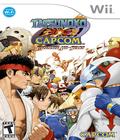Who says companies don't listen to their fans? While most developers are heavily focused on the bottom line, Capcom has been taking a different tack toward the almighty dollar lately. Rather than simply relying on marketing surveys to determine what to sell, the company has made a concerted effort to reach out and engage directly with its most vocal fans. Games like Mega Man 9 and Dark Void Zero with their decidedly retro, 8-bit graphics simply wouldn't have had a shot elsewhere. A game like Tatsunoko vs. Capcom: Ultimate All-Stars would have never made it out of Japan were it produced by any other company. A logistical and licensing nightmare, the acclaimed fighter hit Japanese stores in December 2008. Now, just over a year later, an updated and improved version (thankfully without any sort of "Turbo" moniker) has made its way stateside.
For the uninitiated, Tatsunoko vs. Capcom is the latest in Capcom's "versus" series of fighting games. Much like the ever-popular Marvel vs. Capcom 2, Tatsunoko vs. Capcom pairs Capcom's classic characters with those of another franchise, namely Tatsunoko Productions. A major anime producer in Japan, Tatsunoko Productions has a long and varied history of robust characters, making for a well-rounded roster. Some of the Tatsunoko characters will be familiar to American players, but most will be unknown quantities the first time you slide the game disc into your Wii.
Despite using 3-D character models, Tatsunoko vs. Capcom is a 2-D game at heart. The artwork is detailed and vibrant, with characters and stages that are well rendered. Running in progressive scan, the game looks sharp though a small amount of pixelization can be seen on the character models from time to time. Stage backgrounds are rarely stagnant, with familiar faces making cameos. Where the visuals really stand out is in the animation quality. Fighters move fluidly, and visual effects complement the action rather than obscure it.
Perhaps the strongest element of Tatsunoko vs. Capcom is its extremely shallow difficulty curve. The game is set up so that a rank beginner can jump in, start mashing buttons and not only win against the first few computer opponents, but also look good while doing it. Using the Wiimote and Nunchuk, Tatsunoko vs. Capcom has a simplified control scheme to ensure accessibility. For more experienced players, the game gives you the option of plugging in a classic controller or a GameCube controller and playing in a more traditional style. With only three attack commands, it has fewer buttons than most Capcom brawlers, but the game is balanced to compensate for it.
Advanced combo options provide an even deeper level of play for those who want to truly master the game. Learning the perfect moment to counter versus pushing forward with an all-out assault or aerial rave is all a matter of timing. Move lists can be displayed at the top of the screen, in-game, so the challenge is focused on executing the right move as opposed to trying to blindly guess the right command sequence.
When you first boot up Tatsunoko vs. Capcom, just over 20 characters are visible, though more will be unlocked as you play through the game. Unlocks can sometimes be a contentious issue among gamers; rest assured that there are no unduly onerous unlock requirements here. Keep playing through the arcade mode with different characters, and you'll end up with a full roster in no time.
One of the more creative unlocks is actually an entirely new game, hidden exclusively within the English language version of Tatsunoko vs. Capcom. Dubbed Ultimate All-Star Shooters, the game is an homage to old-school, top-down shooters. Once you get past the repetitive yelling of the characters, it's an addition that adds a noticeable amount of value. Unlocking the game takes a little bit of effort, however. To do so, you must beat the arcade mode and then collect the golden letters as the credits scroll. Miss even one, and you have to take another stab at beating arcade mode from the beginning. On the downside, the inclusion of Ultimate All-Star Shooters means that the character-specific mini-games from the Japanese version of Tatsunoko vs. Capcom didn't make the cut, but it's a trade-off we're willing to live with.
Unfortunately, not everything is roses with the game, as the online mode suffers from quite a bit of lag, making it almost unusable for competitive players and annoying at best for casual players. Given that a number of other fighting games (including other Capcom titles) have managed to implement smooth online play, it's surprising to see Capcom falter here. It's a feature that likely should have been cut before release.
When all is said and done, Tatsunoko vs. Capcom: Ultimate All-Stars is a great example of fan service done right. It's not perfect, but it's close and it fills a niche that has been long underserved on the Wii. With an incredible amount of depth, excellent visuals and plenty of unlockable content to ensure replay value, Tatsunoko vs. Capcom is sure to please just about any fighting game fan out there — even the hardcore Super Smash Bros. Brawl aficionados.
Score: 8.7/10
More articles about Tatsunoko vs. Capcom: Ultimate All-Stars











 Tatsunoko vs. Capcom: Ultimate All-Stars pairs well-known characters from Capcoms roster of games with some of Japans most beloved characters from anime powerhouse Tatsunoko Production. All together, there are more than 20 colorful combatants to choose from in order to form the ultimate tag team combination.
Tatsunoko vs. Capcom: Ultimate All-Stars pairs well-known characters from Capcoms roster of games with some of Japans most beloved characters from anime powerhouse Tatsunoko Production. All together, there are more than 20 colorful combatants to choose from in order to form the ultimate tag team combination.





































